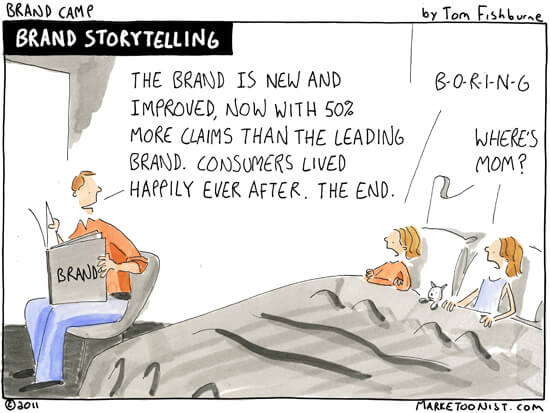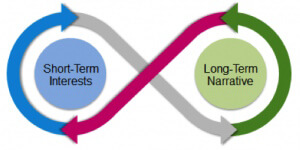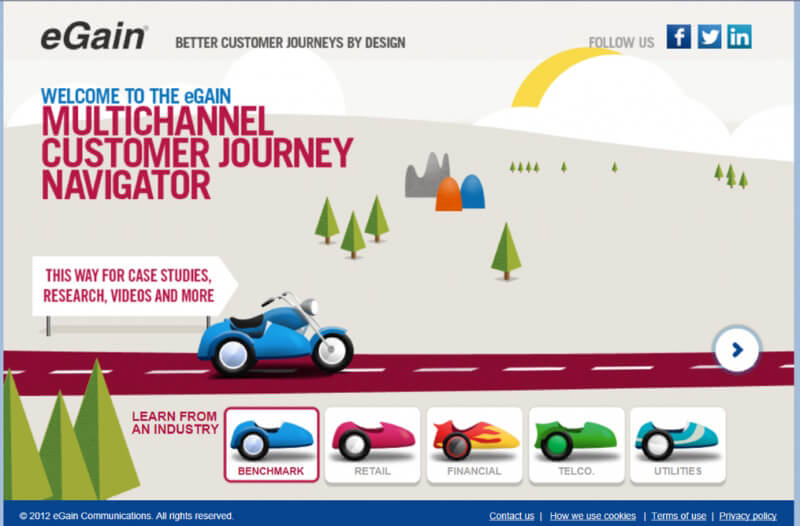How B2B Brand Storytelling Can Benefit Your Brand
There once lived a valiant B2B marketer named Lance. Even though he was incredibly clever, he had been tasked with a particularly arduous mission. His assignment was to create compelling content about one of the most boring products to ever be sold at the market. Not only did he have to write interesting content, he had to create a lot of it.
Lance discovered a magical secret nearly as old as time, which was that every buyer persona loves a good story. By switching his approach from simple information to a narrative, and by creating heroes and conflict, his audience grew.
This new audience wasn’t just there to listen, and suddenly the company’s sales were higher than ever before.
His boss was so pleased he was given an enormous raise, which was enough to buy the shiniest steed in town.

Image source: Marketoonist
Stories aren’t just for children. If there’s a single factor that united B2B and B2C buyer personas regardless of their demographics, it’s a love for the narrative.
Leveraging people’s natural affinity for brand storytelling can transform your content marketing strategy, allowing you to produce content with a natural power to engage your audience. In fact, investing in telling tales could be the most brilliant move you make in the months to come. According to Monte Lutz of Edelman Digital, as companies begin to adjust to the real-time nature of content marketing, it’s easy to lose track of your core brand narrative.
The kind of marketing that stands out and converts isn’t just contextually relevant, it’s consistent with your company’s unique story:

Newsjacking the latest headlines at breakneck speed won’t do your company much good if you’re not creating content that resonates with your audience. The world’s sharpest marketers ensure that every piece of content they create contributes to their company’s unique canon by leveraging the basic elements of the narrative.
We’ve broken down the components of a story told well, as well as included examples of B2B brand storytelling performed using just the right tactics, so you can instantly increase the appeal of your content marketing.
What is a Narrative?
Whether a story is among the canon of Grimm’s fairytales or was penned by a clever content marketer in the past week, it’s going to contain six elements which distinguish a story.
1. Plot: A sequence of events which demonstrate progress or change throughout your story.
After 3 weeks of using our product, our client’s operations department didn’t have to work past 6 pm. In fact, their jobs were so much easier, they were able to schedule time to attend an industry conference.
2. Setting: Placing your story in a context, which will typically include time and place.
In January 2010, ABC Incorporated was experiencing their sixth consecutive month without a profit. If something didn’t change soon, they would need to start laying off staff.
3. Characterization: The process of defining the hero or villain of your brand storytelling.
Much like many SMB CEOs, Jeff Hero’s job was his life. He often worked 12-14 hour days, and hadn’t taken a paycheck home in nearly a year.
4. Atmosphere: The process of instilling emotion or affinity in readers through tone, voice, and pacing.
It had been a particularly cold winter in Minnesota, but no one was feeling the chill of February approaching more than Jeff Hero and his bookkeeper.
5. Point of View: Creating a consistent voice by choosing to tell a story in the first or third person, and using quotation marks to signify the transition of the point of view.
When we asked Jeff Hero why he decided to pursue a different operations software for his company, he shrugged:
“I really didn’t feel I had much of a choice.”
6. Conflict: Conflict can be internal or external, but every story needs a problem to create interest and turn your corporate fact sheet or client data into brand storytelling.
The day before Jeff Hero decided to purchase our software, his bookkeeper gave him some sobering news. Unless their profits turned around, the company wouldn’t survive three months.
Whether you’re writing a case study or blog post, your story should include all six of these basic elements. If you fail to define your hero or atmosphere, your content marketing may not compel your reader as effectively.
Examples of Brand Storytelling Done Right
Anyone who says B2B content marketing is easy is either a genius or new to the field.
The discipline is notoriously tough, particularly for professionals tasked with creating content around products or services with limited appeal. As Brooke Howell points out, “it can be hard to get a conversation started…by business customers or create viral appeal.” However, it’s not impossible and there are most definitely companies who’ve nailed it.
We’ve shared insights into the best work of a few favorites:
Cisco
Cisco’s content marketing is so good, it’s become the stuff of legend among content marketers. This company that manufactures networking equipment doesn’t just tell tales that B2B decision makers want to read, they’ve invested in telling them well and often:

Eloqua reports that Cisco’s news website, cleverly named “The Network” revolves around frequently-updated news stories on technology, written by some of the world’s brightest journalists. Each of these well-researched and compelling stories about the intersection of business and technology contributes to the larger fabric of their brand storytelling, as a company at the forefront of tech.
Xerox
While this example of brand storytelling from imaging giant Xerox is aimed at recruitment, it’s worthy of the spotlight because it’s so incredibly effective:

Whether you’re trying to recruit marketers, executive assistants or graphic designers, there’s a fair chance they want to be recognized, appreciated, and contribute to something great. By presenting a current employee as a thought-leading hero, Xerox effectively compels talent to consider becoming a part of their company.
eGain
The only thing cleverer than creating a well-crafted narrative is mixing brand storytelling with elements of gamification. eGain doesn’t just make apps for customer relationship management software, they’ve created one of the best web experiences we’ve ever encountered. From the moment customers step foot on the website, they’re made the heroes, and allowed to customize their discovery experience by industry:

The eGain user experience is a bit like stepping into a great big library, and being able to pick the story you want to read most.
Takeaway
Whether you’ve resisted using brand storytelling as a content strategy, or you’re not quite sure where your company falls on the spectrum, marketer Katya Anderson cautions that the following tactics definitely aren’t an effective narrative:
- Stating Your Company Mission
- Spewing Jargon
- Boring Content
Does that mean there’s no place for a clearly-stated manifesto on your website? Absolutely not. Define your values, but don’t use your blog as a platform for talking about what you do. Make the shift to describing why it matters to your customers, and how it has helped their business. Brand storytelling done the right way can compel your prospects with social proof, and create an audience that’s engaged enough to keep listening.
Are you currently using brand storytelling as a narrative tactic? Are there any B2B companies you’d add to this list of narrative heroes?

Comments (0)